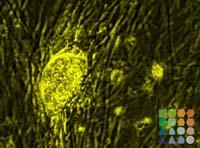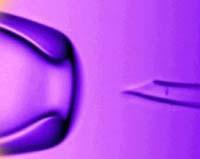First human clone

The aim of the experiment has not been to create a copy of a person. The truth is that so far they have only been done in science fiction, and in addition it is not that intention of the researchers. On the contrary, it is about obtaining stem cells compatible with the patient. Since stem cells are the origin of all other types of cells, researchers expect them to be very useful for their therapeutic use and, in addition, if they have the same genetic information as the patient, do not produce problems of rejection.
However, there is still much to do, and California researchers have recognized that their work is just a small step. That is, small but important. They have not actually used any innovative technique, but have been based on the same nuclear transfer technique that Dolly used to create the famous sheep. But, unlike so far, they have been successful.
Researchers have departed from the surface cells of an adult man. In addition, eggs have been used, 29 eggs provided by three young women. In fact, the nucleus of the cutaneous cell is integrated into an egg. To do this, the nucleus must first be removed from the ovules, then the nucleus of the skin cell is injected and then the ovules are excited. Thus, the embryo begins to develop.

In this way, the researchers have managed to develop five embryos until the blastocyst phase. Obtaining this number of embryos of 29 eggs is a very satisfactory result, since although the technique is quite advanced in some animal species, usually many embryos are lost along the way. According to the researchers, there are several factors that have joined together to achieve this success.
On the one hand, they have used eggs of very good quality. The three women who have donated eggs are young from 20 to 24 years old and although they were in in vitro fertilisation treatment do not have fertility problems. The researchers asked the women that the eggs were in that treatment and they allowed them to use ovules other than in vitro fertilisation.
On the other hand, hyaluronidase is one of the components of the means necessary for the growth of cells in the laboratory and is usually cow. On this occasion they have used human hyaluronidase. These and other details have contributed to success.
In fact, in the cloning experiment they have achieved a result similar to that of in vitro fertilisation. In vitro fertilisation, 70-80% of the initial eggs (with a sperm) are fertilised, of which 40-60% reach the blastocyst phase. In the California cloning experiment, the results are similar, as five embryos of 29 eggs have been obtained.
Two of these embryos contain the genetic information of an egg donor, so they are not clones of man, with which the experiment has failed. Another three can be the clones of the donor of the cutaneous cell, and at least in one of the embryos have shown that yes, which is the clone of man.
Once the blastozisto was achieved by cloning, the next step would normally be to try to get stem cells from there. However, the researchers have not done so, they have used the embryos to show whether they are clones or not, and they have remained there. Other researchers working in the same field have been surprised by this, but California researchers have responded that, before moving forward, they wanted to be sure that the steps taken so far have been correct. In addition, only from 10-20% of blastocysts manage to develop stem cells, so to go ahead they did not have much chance of success.
Ethical and legal problems

Regardless of success, this stem cell collection technique is limited by the need for female eggs and by ethical and legal problems to achieve them. In this case, women have donated their eggs voluntarily. But many times, when researchers need eggs, donors receive hormonal treatment. This treatment has side effects and women are usually compensated. This generates ethical doubts because you cannot know who gives the eggs because science wants to advance and who needs money.
To avoid the need for eggs and to avoid such problems, several groups of researchers are testing another way to get stem cells. It is based on the reprogramming of mature cells of the patient and are already obtaining good results. In any case, stem cell researchers continue to have a long way ahead. To see if, on the one hand or on the other, they get, step by step, to reach the goal.
Published in Gara
Buletina
Bidali zure helbide elektronikoa eta jaso asteroko buletina zure sarrera-ontzian











